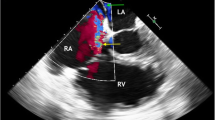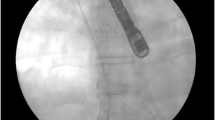Abstract
We report a case in which excessive negative pressure may have been applied to the proximal side hole of a drainage cannula during venovenous extracorporeal membrane oxygenation (V-V ECMO), resulting in abnormal stenosis of the drainage cannula. V-V ECMO was introduced in a 71-year-old male patient who was transferred from another hospital for severe respiratory failure associated with varicella pneumonia and acute respiratory distress syndrome. Drainage was performed using a PCKC-V™ 24Fr (MERA, Japan) cannula via the right femoral vein with the tip of the cannula near the level of the diaphragm under fluoroscopy. Reinfusion was performed via the right internal jugular vein. Due to poor systemic oxygenation, the drainage cannula was withdrawn caudally and refixed to reduce the effect of recirculation. Two days later, drainage pressure dropped rapidly, and frequent ECMO flow interruption occurred due to poor drainage. An abdominal X-ray revealed abnormal stenosis of the proximal side hole site of the drainage cannula. We diagnosed that the drainage cannula was damaged, and it was replaced with another, namely a Medtronic Bio-Medicus™ 25 Fr (GETINGE, Sweden) cannula. However, the removed drainage cannula was not damaged, suggesting that the cannula was temporarily stenosed by momentary excessive negative pressure. In a multi-stage drainage cannula, the main drainage site is the proximal side hole, with little negative pressure applied at the apical foramen in a mock experimental ex vivo drainage test in a water tank. Hence, improvement of a multi-stage drainage cannula is recommended, such as adequate reinforcement of the side hole site with a wire.

Similar content being viewed by others
Data availability
The supplemental videos that support the findings of this study are available from the corresponding author, TN, upon reasonable request.
References
Abrams D, Bacchetta M, Brodie D. Recirculation in venovenous extracorporeal membrane oxygenation. ASAIO J. 2015;61:115–21.
Banfi C, Pozzi M, Siegenthaler N, et al. Veno-venous extracorporeal membrane oxygenation: cannulation techniques. J Thorac Dis. 2016;8:3762–73.
Fortuna P, Germano N, José C, Martins A. Multistage ECMO cannulas: first holes get it all? Intensive Care Med. 2017;43:1725.
Lindholm JA. Cannulation for veno-venous extracorporeal membrane oxygenation. J Thorac Dis. 2018;10:S606–12.
Şahin T, Tezer M, Cerit L. Hydrodynamic evaluations of four mock femoral venous cannulas. Braz J Cardiovasc Surg. 2018;33:435–42.
Acknowledgements
None
Author information
Authors and Affiliations
Contributions
All authors contributed to this case report. Tomoyuki Nakamura, Yoshitaka Hara, and Tomoaki Yamashiro conducted the drainage experiment. The first draft of the manuscript was written by Tomoyuki Nakamura and all authors commented on previous versions of the manuscript. All authors read and approved the final manuscript.
Corresponding authors
Ethics declarations
Conflict of interest
None.
Informed consent
Written informed consent was obtained from the family of the patient for the publication of this case report and the accompanying images.
Additional information
Publisher's Note
Springer Nature remains neutral with regard to jurisdictional claims in published maps and institutional affiliations.
Rights and permissions
Springer Nature or its licensor (e.g. a society or other partner) holds exclusive rights to this article under a publishing agreement with the author(s) or other rightsholder(s); author self-archiving of the accepted manuscript version of this article is solely governed by the terms of such publishing agreement and applicable law.
About this article
Cite this article
Nakamura, T., Kuriyama, N., Hara, Y. et al. Abnormal stenosis of a drainage cannula due to excessive negative pressure during venovenous extracorporeal membrane oxygenation management: a case report. J Artif Organs (2023). https://doi.org/10.1007/s10047-023-01414-y
Received:
Accepted:
Published:
DOI: https://doi.org/10.1007/s10047-023-01414-y




